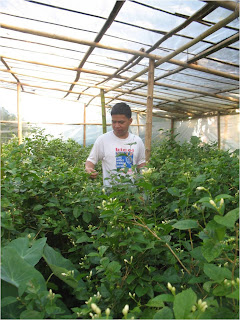I am a Farmer
It was a hot summer day. The
scorching weather condition makes the house turn into an instant “oven”. The
unbearable heat almost burns my skin inside. Hot air is blown by the fan making
it more useless. I was in Nueva Ecija then. I was working in a government
agency concerning agriculture. Prior to my assignment here, I was managing my
family’s farm. Though the two works are both engaged in agriculture, the
functions are entirely different.
At the age of 19, I took over
the managing of our farm. As manager, I was engaged in the decision-making,
planning, and directing not only the production but also in the marketing of
our produce, which was flowers. As early as 5 in the morning, before the rooster’s
crow, I was already in the farm. During the peak of harvest, I, together with
my mother, lead the harvesting operation so as to have an immediate product to
be marketed at the later part of the day. 30 minutes to one hour, or
brothers/sisters will join me in the harvest. It takes us 3 hrs to complete
harvesting the 600-m2 sampaguita farm. By 8 am, sunlight becomes a challenge to
finish or not the operation. It would be continued at the less heat-intense
period of the day, e.i. 4-5 pm. However, it’s not
Figure
1.0 Harvesting of sampaguita flower
Figure 2.0 Newly harvested sampaguita flowers
Figure 3.0 Freshly sewn sampaguita garland (especially made for graduation
ceremonies) ready for
marketing
Figure 4.0 Manual sewing of sampaguita garland
Figure 5.0 Termed as “ordinary”, this is the most common available form of sewn
garland in the market year-
round
Figure 6.0 My
dearest mother, Ana, sipping coffee to revitalize her body from exhausting
field harvesting
Figure 7.0 There
are still lots of sampaguita flowers to be harvested
Figure 8.0 My
sister, Mary Joy and Mary Ann, enjoyable picking up the flowers
Figure 9.0 A close-up
view of the sampaguita buds
Figure 10.0 Inside the greenhouse of sampaguita plants
Figure 11.0 Violet
strellita is used to complement the sampaguita garland
Figure 12.0 Peak
season harvest of sampaguita when it was not yet covered in greenhouse
the case always. Harvesting
may be extended until 10 in the morning and restart harvesting at 2 pm. imagine
the temperature of that part of the day! In fact, it’s the time the state-run
weather station discourages the public to stay under the sun’s light.
On my elementary days, summer is
the peak season of sampaguita flowering. We used to harvest at my aunt’s farm. I
can still remember when my mother would tell me to take a nap in the afternoon
(which I always defy). Instead, after lunch, I would sneak and walk the 1-km
distance from our house to my aunt’s farm. The farm is located along the rice
farm. There would be no shades except to the occasional large clouds that cover
the sun. I could bear the heat without even replenishing the lost water. After
one or two hours, I would go home.
My mother would call me then,
“Sandy! How many times would I tell you not to go in the farm in this time of
the day?”
I would just smile as a
response.
Back in Nueva Ecija. It saddens me remembering those
memoirs. If was only at home, I might not be on an “oven” right now. I am
suffering from this harsh weather not on-farm but at this heavily insulated
house. I am a farmer...and I need to go
back to my farm.
















































